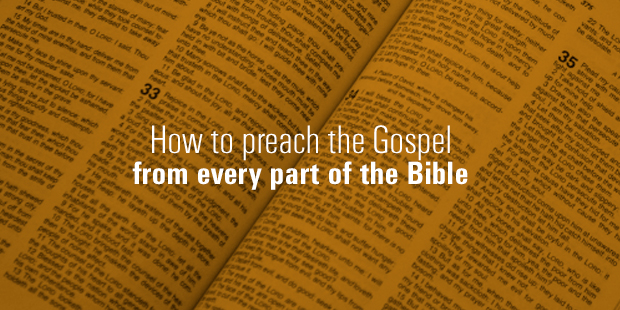
How to Preach the Gospel from Every Part of the Bible
I love it when I hear students and pastors ask how our sermons can be more gospel-shaped in the regular course of preaching — even sermons from narrative or hortatory passages, for example. I love it because it shows their interest to do what every preacher of God’s Word ought to strive to do, and I love it because it forces me again to think through the question myself and determine how I can more faithfully minister God’s Word. Of course I have by no means finished thinking these matters through, but here are some thoughts.
Types of “Gospel Passages” in Scripture
First we need to recognize the various ways in which the gospel is addressed or reflected in various biblical passages. For example, a given passage will be more or less exhaustive. No passage will be completely exhaustive in itself. Some emphasize the person of Christ, some the work of Christ. Some emphasize substitution, some his work of triumph. And so on, as we will see below. Each passage will need to be understood in light of the whole.
Again, some passages are explicitly gospel shaped. Isaiah 53, John 3, Romans 3:21ff, Hebrews 9-10 come to mind here. And others are more subtly but just as certainly gospel shaped, such as Genesis 15, Leviticus 16, the book of Ruth, John 2, and so on. And still others are only implicitly gospel shaped. Examples here would include 1 Samuel 17 (David and Goliath), Joshua 6 (Rahab), the Gospel miracle accounts, and even wisdom and hortatory passages, as we will see.
Some passages (and contexts) are preparatory to the gospel and merely anticipate it in some way, while others show its accomplishment and realization. Here the distinction between Old and New Testament passages is prominent. The Old Testament preparation for the gospel takes many forms — type, prophecy, good and bad examples, rebellious Israel, failing kings and judges, and so on. The Old Testament is often helpfully viewed as a “historical drama” which, understood in its redemptive-historical flow, is seen to point us in a variety of ways to gospel truth later revealed in Christ.
Once again, some passages focus more on the need of the gospel, while others focus more on the solution. The need for the gospel may be seen in rebellious Israel or in individual sinners, and it may be seen in the general fallenness of humanity that is evidenced in the sufferings and weaknesses, even illness and death, that are common to us all. And the solution may be seen in God’s faithfulness, his patience, his unfailing purpose, his promise, dramatic rescues, the many presentations of Christ and his work, and so on.
Finally, some passages emphasize the means of redemption, while others its effects or consequences and entailments. Christ may be displayed (BC or AD) as priest, sacrifice, redeemer, substitution, champion, etc.. Or the passage may emphasize rescue, safety, conversion/transformation, exhortation to obedience-faithfulness.
All this is to say that not all gospel-shaped sermons sound the same. Not ever passage approaches or reflects the gospel in the same way. Our job as preachers is simply, as Bryan Chapell says so crisply, “not … to discover where Christ is mentioned in every text but to disclose where every text stands in relation to Christ” (Christ Centered Preaching, p.279).
That is to say, it is not the preacher’s job to find creative and inventive ways of running from the text to the gospel. The gospel is reflected in Joshua 6 not because Rahab’s cord was red but because it speaks of God’s deliverance for the helpless and for sinners. We needn’t imagine that the center board on the back wall of the tabernacle represents eternal security. We have all heard these fanciful approaches, the underlying hermeneutic of which seems to be found only in the preacher’s fertile imagination. A more responsible approach simply seeks to understand the passage in its canonical flow and to treat it accordingly.
But still we are not done. What follows are some considerations, first general and then more specific, that can help us toward gospel-shaped sermons.
General Considerations & Suggestions
- Keep what I call “the big picture” — the Bible story line — in mind always. Where does this given passage fit in relation to the whole?
- Bear in mind the twin gospel promises of justification and transformation. The gospel promises not only rescue from sin’s punishment but also from its rule and dominion, and a given passage may stress one or the other.
- Bear in mind always the redemptive purpose and power of the preached Word. It is the means by which God works both to claim and to transform his people.
- Understand the difference between teaching and preaching. Teaching merely explains a given passage of Scripture. Preaching is designed (as Tim Keller says it) to make it live.
All this is preliminary. Now to some specific and more practical “hands on” guidelines to help us preach the gospel from every passage of Scripture.
Specific Suggestions when Approaching a Preaching Passage
- Locate the passage canonically. How does the book and larger context serve to anticipate or display or otherwise reflect gospel truth?
- Locate the theme and application theologically. We should ask how this passage addresses or reflects God’s redemptive purpose and/or its need.
- Select your preaching passage carefully. We should serve the cake whole, in its completed form, not each of the separate ingredients that went into its baking.
- Keep the gospel prominent and explicit. To preach the Scriptures rightly we must be careful to maintain its own redemptive focus, a focus that rivets our attention, from first to last, on our glorious Redeemer.
He is, after all, the one about whom the book was written.
Read the full story here.
Read more from Fred here.

Tags: Fred Zaspel, Gospel, Scripture











